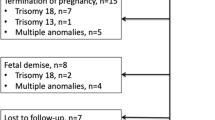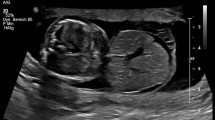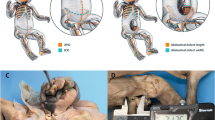Abstract
Purpose
To investigate the relationship between the thorax diameter and defect diameter of giant omphaloceles as a predictor for fetal outcome.
Methods
In a retrospective study, 17 fetuses with isolated giant omphaloceles were included for evaluation. The anterior–posterior thorax diameter and the defect diameter were measured from ultrasound images. For analysis, the thorax-to-head ratio (T/HC), the defect diameter-to-head ratio (DD/HC), and the quotient of the defect diameter and the thorax diameter (DD/T) were calculated. The days of ventilation (t ventilation), the duration until hospital discharge (t hospital), and the type of treatment were recorded as outcome parameters.
Results
No relationship was found between the calculated ratios (T/HC, DD/HC, or DD/T) and neither t hospital (r = −0.418, p = 0.095; r = −0.153, p = 0.556; and r = −0.023, p = 0.929; respectively) nor t ventilation (r = −0.391, p = 0.121; r = 0.041, p = 0.875; and r = 0.121, p = 0.645, respectively). The type of postnatal treatment was not associated with the three calculated ratios or t hospital (r = 0.155, p = 0.553; r = 0.019, p = 0.942; and r = 0.012, p = 0.965; r = −0.009, p = 0.973, respectively). In 53% of cases, t hospital was delayed due to additional and independent postnatal complications.
Conclusion
Thorax diameter or defect diameter of giant omphaloceles is not predictive for fetal outcome. The perinatal care of these abdominal wall defects still remains a multidisciplinary challenge, but the outcome of giant omphaloceles is favorable at experienced centers.


Similar content being viewed by others
References
Christison-Lagay ER, Kelleher CM, Langer JC (2011) Neonatal abdominal wall defects. Semin Fetal Neonatal Med 16:164–172
EUROCAT. http://www.eurocat-network.eu. Accessed 18 Sept 2016
Prefumo F, Izzi C (2014) Fetal abdominal wall defects. Best Pract Res Clin Obstet Gynaecol 28:391–402
Kouame BD, Odehouri Koudou TH, Yaokreh JB, Sounkere M, Temberly S, Yapo KGS, Boka R, Koffi M, Dieth AG, Ouattara O, da Silva A, Dick R (2014) Outcome of conservative treatment of giant omphaloceles with dissodic 2% aqueous eosin: 15 years’ experience. Afr J Paediatr Surg 11:170–173
Peters NCJ, Visser ‘t Hooft ME, Ursem NTC, Eggink AJ, Wijnen RMH, Tibboel D, Bonsel GJ, Cohen-Overbeek TE (2014) The relation between viscero-abdominal disproportion and type of omphalocele closure. Eur J Obstet Gynecol Reprod Biol 181:294–299
Montero FJ, Sompson LL, Brady PC, Miller RS (2011) Fetal omphalocele ratios predict outcomes in prenatally diagnosed omphalocele. Am J Obstet Gynecol 205:284.e1–284.e7
Kleinrouweler CE, Kuijper CF, van Zalen-Sprock MM, Mathijssen IB, Bilardo CM, Pajkrt E (2011) Characteristics and outcome and the omphalocele circumference/abdominal circumference ratio in prenatally diagnosed fetal omphalocele. Fetal Diagn Ther 30:60–69
Kiyohara MY, Brizot ML, Liao AW, Francisco RPV, Tannuri ACA, Krebs VLJ, Zugaib M (2014) Should we measure fetal omphalocele diameter for prediction of perinatal outcome? Fetal Diagn Ther 35:44–50
Tassin M, Descriaud C, Elie C, Houfflin Debarge V, Dumez Y, Perrotin F, Benachi A (2013) Omphalocele in the first trimester: prediction of perinatal outcome. Prenat Diagn 33:497–501
Kamata S, Usui N, Sawai T, Nose K, Fukuzawa M (2008) Prenatal detection of pulmonary hypoplasia in giant omphaloceles. Pediatr Surg Int 24:107–111
Hershenson MB, Brouillette RT, Klemka L, Raffensperger JD, Poznanski AK, Hunt CE (1985) Respiratory insufficiency in newborns with abdominal wall defects. J Pediatr Surg 20:348–353
Argyle JC (1989) Pulmonary hypoplasia in infants with giant abdominal wall defects. Pediatr Pathol 9:43–55
Headley BM, McDougall PN, Stokes KB, Dewan PA, Dargaville PA (2001) Left-lung-collapse bronchial deformation in giant omphaloceles. J Pediatr Surg 36:846–850
Danzer E, Hedrick HL, Rintoul NE, Siegle J, Adzick NS, Panitch HB (2012) Assessment of early pulmonary function abnormalities in giant omphaloceles survivors. J Pediatr Surg 47:1811–1820
Tsakayannis DE, Zurakowski D, Lillehei CW (1996) Respiratory insufficiency at birth: a predictor of mortality for infants with giant omphaloceles. J Pediatr Surg 31:1088–1091
Merz E, Wellek S, Bahlmann F, Weber G (1994) Sonographische Normkurven des fetalen knöchernen Thorax und der fetalen Lunge. Geburtshilfe Frauenheilkd 55:77–82
Snijders RJM, Nicolaides KH (1994) Fetal biometrie at 14–40 weeks’ gestation. Ultrasound Obstet Gynecol 4:34–48
Fleiss JL (1999) Reliability of measurement. The design and analysis of clinical experiments. Wiley, New York, pp 1–32
Schwaitzberg SD, Pokorny WJ, McGill CW, Harberg FJ (1982) Gastroschisis and omphalocele. Am J Surg 144(6):650–654
Bauseler A, Funke K, Möllers M, Hammer K, Steinhard J, Borowski M, Müller V, Klockenbusch W, Schmitz R (2016) Outcome of fetuses with gastroschisis after modification of prenatal management strategies: prenatal management and outcome of gastroschisis. Arch Gynecol Obstet 294:239–243
Ali Z, Schmidt P, Dodd J, Jeppesen DL (2013) Bronchopulmonary dysplasia: a review. Arch Gynecol Obstet 288:325–333
Author information
Authors and Affiliations
Corresponding author
Ethics declarations
Funding
None.
Conflict of interest
None declared.
Ethical approval
All procedures performed in studies involving human participants were in accordance with the ethical standards of the institutional and/or national research committee and with the 1964 Helsinki declaration and its later amendments or comparable ethical standards.
Informed consent
The institutional review board approved this study and required neither patient approval nor informed consent for our retrospective analysis of data that were obtained using a standard of care clinical protocol.
Rights and permissions
About this article
Cite this article
Diemon, N., Funke, K., Möllers, M. et al. Thorax-to-head ratio and defect diameter-to-head ratio in giant omphaloceles as predictor for fetal outcome. Arch Gynecol Obstet 295, 325–330 (2017). https://doi.org/10.1007/s00404-016-4236-1
Received:
Accepted:
Published:
Issue Date:
DOI: https://doi.org/10.1007/s00404-016-4236-1




